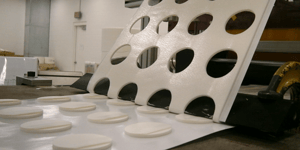Have you noticed die cut foam tape in your daily life? Whether you’ve noticed or not, foam tape is all around us.
Strouse’s engineering team works with die cut foam projects daily. Learning about the potential uses of foam tape will allow you to consider it for future projects.
Let’s review how die cut foam is used and where you can find it.
WHAT IS DIE CUT FOAM?
Die cut foam components are created from die cutting, the process of using a die cut tool to punch out shapes from a material.
5 Die Cut Foam Applications
Thanks to its adaptability, die cut foam is used in a variety of situations, from mounting heavy objects on the wall to sealing electrical outlets. Today, we’ll review how it’s used in different industries.
1. MEDICAL
There are many reasons why die cut foam tape is ideal for medical applications.
Die cut foam is also flexible and comfortably rests against human skin. Because people aren’t flat surfaces, it’s essential to use materials that bend easily.
Foam tapes also bond together medical devices and secure dressings to the skin. The foam provides cushioning to protect wounds, effectively forming a soft barrier between the skin and the outside.
- Gaskets and seals
Die cut foam tape can create an airtight seal to keep out pollutants and maintain a wound's temperature/humidity balance. This airtight seal has many applications in skin adhesives and is used in between rooms or to seal equipment.
- Monitoring devices
As hospitals express their growing interest in advanced monitoring technology, the die cut market continues to expand.
WEARABLES
Wearable devices, AKA “wearables,” are often used for monitoring patient vital signs. Die cut foam tape’s stick-to-skin advantage is a valuable tool when applying wearables.
Due to reusability campaigns, most wearables have a limited or extended lifespan, but durability has become more prevalent in recent years. Even the most minor debris can promote mold growth or harm a sensitive skin area.
Certain materials belong in sterilized sites like Strouse’s Clean Room, which has the intent and capabilities to process them away from contamination.
2. ELECTRONICS
When it comes to the electronics industry, die cut foam tape bonds together circuit board assemblies and touchscreens.
- Circuit board assemblies & Touchscreens
Typically, the tape used in these applications is thin foam tape that can fit into the device while cushioning its insides.
The impact or shatter resistance within these devices is higher when using thin foam tape, and these devices have a more substantial chance of holding up against heat or water.
In addition, die cut foam can create a robust seal to keep out dirt and other particles.
3. AUTOMOTIVE
Whether it’s commercial vehicles, truck bodies, or public service vehicles, a portion of the automotive industry has adapted to using acrylic foam tapes instead of bolts and screws.
- Powerful bonding adhesive
Besides attachment purposes, die cut foam tape has multiple advantages over bolts and screws.
Firstly, it can function as a standard adhesive while providing noise/vibration reduction. Secondly, die cut tape is a less obvious, more aesthetically pleasing interior alternative to adding trim through other means. Lastly, acrylic foam tapes without primer are a low health risk to employees and can mitigate costs in that area.
While automotive die cut adhesives are often used for surface detailing, die cut foam tape is also frequently used under the hood.
Many of the specialized foams used in converting, like polyurethane (PE), can resist heat and pressure. This trait lends itself to sitting in proximity to a car’s engine.
4. AEROSPACE
Die cut foam tape reduces the number of bolds and screws on the exterior of planes or helicopters. Similar to its function within auto interiors, it can also function as an interior bonding or dampening material.
- Panel securement
Foam tape has a unique advantage in aerospace applications: lessening the drag caused by larger surface fasteners. In addition, using foam tape instead of bolts or screws can drastically reduce the weight of connecting pieces.
- Cushioning or protection
Aerospace manufacturers also use PE foam tapes to cushion critical electronic components. Custom foam pieces can brace technology in place as an additional protective measure.
5. ENERGY & ELECTRICAL
Fragile technology, such as solar panels and inverters, requires careful set-up to function as needed.
- Bonding solar panels
Acrylic foam tape is flexible and UV resistant, making it ideal for building or patching up solar panel banks and inverters.
Nowadays, companies produce foam tapes designed for the solar panel industry. 3M have an entire section dedicated to solar energy foam tapes on their website!
Solar panels are made up of a network of thin wires connecting to the terminal so that they can carry the converted electricity. These panels are also exposed to the natural elements and can benefit from additional internal connective pieces.
These delicate parts use thin components such as die cut foam tape to hold everything in place.
Where Can I Find Die Cut Foam Tape?
While custom foam tape sadly doesn’t grow on trees, it’s well within reach if you contact a converter.
Simple or more generic die cut shapes are often possible to find online, but when it comes down to custom die cut foam parts, contacting a converter is likely the route you’ll go.
Die cut converters can help you locate a material, optimize your design for production, and devise the most efficient means of manufacturing. Reach out for a quote today and we'll guide you through our product development process.
Originally published: October 26, 2022
%20(1)-min%20(1).png?width=290&name=Untitled%20(52)%20(1)-min%20(1).png)






